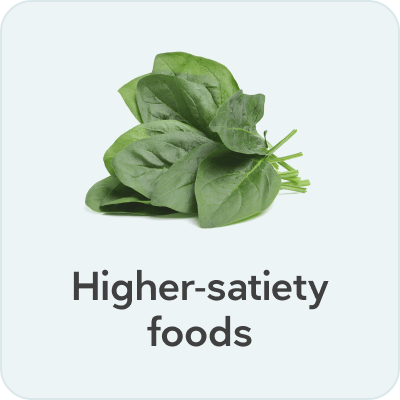Adding higher-satiety foods to your keto diet
Evidence based
Ketogenic diets can help with weight loss, diabetes control, and metabolic health. They can also lead to lower levels of hunger.
In a way, keto diets are an example of a higher-satiety diet. Many participants following a keto diet in scientific studies report less hunger and decreased food intake than other participants following higher carb diets. Improved satiety may occur because keto diets tend to have more protein and less craving-stimulating foods than a standard Western diet. There is also evidence that the elevated ketone levels that result from a keto diet may be beneficial for reducing hunger.
But is it possible to tweak your keto diet to make it even more satisfying? Or to make you feel satisfied after eating fewer calories? At Diet Doctor, we think the answer to that question is yes!


Higher-satiety keto
Higher-satiety keto focuses on reducing carbs to stay in nutritional ketosis, while increasing protein and fibrous vegetables, and lowering excess added fat.
The idea of “lowering excess added fat” might sound like traditional low fat diet advice. Rest assured, that is not the case. On higher-satiety keto, you’ll still get plenty of calories from fat.
But since fat is so packed with calories — with nine calories for every gram — this approach recommends lowering added fat somewhat. Instead, you’ll add more satiating calories from protein and low carb vegetables.
For example, instead of eating 5% of your calories from carbs, 20% from protein, and 75% from fat, on a higher-satiety keto diet you might eat 5-8% carbs, 32-35% protein, and 60% fat.
Higher-satiety keto is far from a “low fat diet,” which might only source 20% of calories from fat. Rather, it’s more like a “moderately high fat,” higher protein, ketogenic diet.
Are you wondering what this means from a practical standpoint?
Let’s start with the most important concept: how to build a meal.
Pick your protein first, and make sure it is a generous portion that will help you meet your daily protein target. Add plenty of high fiber veggies, and add just enough fat for taste (and extra calories if they are needed).
Next, here are some practical suggestions for transitioning from a higher fat keto diet to a higher-satiety-per-calorie keto diet.
- Don’t add butter, cream, or MCT oil to your coffee.
- Enjoy the ribeye steak, but don’t put butter on it.
- Keep the skin on your chicken, but don’t smother it with a cream sauce.
- Eat whole eggs for breakfast, but pair them with Canadian bacon or lean turkey bacon instead of regular bacon.
- Cut back on creamy or cheesy casseroles.
- Be careful with nuts. They are very tasty and the calories quickly add up.
- Eat avocados and olives, but don’t think of them as “free” foods.
- Put less dressing on your salad and less butter on your veggies. (Not none, just less.)
- Have a burger, not a bacon cheeseburger.
- Ditch the fat bombs for one square of dark chocolate.
- Instead of berries and whipping cream, have berries with high protein Greek yogurt or cottage cheese.
Who should try higher-satiety keto?
Are you succeeding on a ketogenic diet, losing weight, improving your health, and enjoying the lifestyle? If so, then you likely don’t need to change a thing. If your keto diet is working for you in all these areas, stick with what you are doing.
But what if you had initial health and weight loss success on a keto diet but then stalled or regressed? In that case, you may want to try higher-satiety keto. Keeping carbohydrates low and increasing satiety per calorie can be a powerful combination to kick-start your health and weight loss progress.
Or, what if you struggle with strict carb reduction or are uncomfortable in family settings, social engagements, or feel deprived too often?
In that case, you may want to try a higher-satiety moderate or liberal low carb diet, essentially reducing fat somewhat while increasing protein and healthy carbs. You may find you can maintain the health and weight loss benefits you gained from a keto diet while simultaneously increasing your food variety and reducing your feelings of deprivation.
A higher-satiety keto diet may not be the right choice for everyone, however. If you’re eating a keto diet that was prescribed by a clinician to treat a neurologic or mental health condition, such as migraines, seizures, or bipolar disorder, you may not want to change to a higher-satiety ketogenic diet.
As always, be sure to discuss any dietary changes with your prescribing clinician.
Protein and ketosis
Eating higher-satiety-per-calorie food usually results in eating a higher protein diet.
Some people may be concerned that a higher protein approach will “kick you out of ketosis” or increase your blood sugar.
Chances are it won’t.
Studies show that meals with 50 grams of protein or 30% protein diets are perfectly compatible with improved blood sugar and nutritional ketosis. So, although the basic science is correct — protein does stimulate an insulin response and may raise blood sugar if there is an inadequate insulin response — in practice, it is rarely significant.
Don’t I need to eat fat to be in ketosis?
No! You don’t need to eat fat to be in ketosis. That is a myth about ketosis.
In truth, the most effective way to get into ketosis is to fast. That’s right. Eating nothing gets you into ketosis faster than any diet plan — absolutely zero fat is required.
Of course, you can’t fast forever, so if you want to stay in ketosis, you need to find a sustainable way of eating. The key is to reduce your carbs so that your body produces ketones. You fill in the rest of your calories with protein and fat.
As we like to say at Diet Doctor, prioritize your protein, limit your carbs, and add fat to enjoy your food or if you need extra calories. But that doesn’t mean you have to go out of your way to eat as much fat as possible. Use fat as a tool to enjoy your food and an energy source, as needed.
You can read more keto myths about fat and weight loss in our dedicated guide.
Give it a try
Ready to get started with a higher-satiety keto diet?
We’ve developed a satiety score to help you assess foods and recipes. It’s on a scale of 0 to 100, and the most satisfying foods (per calorie) score highest. You can read more about it in our guide, Introducing our satiety score.
Aim for a blended satiety score of around 50 each day. You can always adjust that number up or down if you need to.
Want faster results? Try for a blended score of 70 or higher.
Want more choices and variety? See how you do when you target a blended score of 40.
You can read more about eating for satiety in our beginners’ guide: Higher-satiety eating: what it means & how to get started.
Adding higher-satiety foods to your keto diet – the evidence
This guide is written by Dr. Bret Scher, MD and was last updated on September 14, 2022. It was medically reviewed by Dr. Michael Tamber, MD.
The guide contains scientific references. You can find these in the notes throughout the text, and click the links to read the peer-reviewed scientific papers. When appropriate we include a grading of the strength of the evidence, with a link to our policy on this. Our evidence-based guides are updated at least once per year to reflect and reference the latest science on the topic.
All our evidence-based health guides are written or reviewed by medical doctors who are experts on the topic. To stay unbiased we show no ads, sell no physical products, and take no money from the industry. We’re fully funded by the people, via an optional membership. Most information at Diet Doctor is free forever.
Read more about our policies and work with evidence-based guides, nutritional controversies, our editorial team, and our medical review board.
Should you find any inaccuracy in this guide, please email andreas@dietdoctor.com.
International Journal of Endocrinology 2021: Comparing the efficacy and safety of low-carbohydrate diets with low-fat diets for type 2 diabetes mellitus patients: a systematic review and meta-analysis of randomized clinical trials [strong evidence]
Journal of Nutritional Science 2021: Restricting carbohydrates and calories in the treatment of type 2 diabetes: a systematic review of the effectiveness of ‘low-carbohydrate’ interventions with differing energy levels [strong evidence]
Current Diabetes Reports 2021: Efficacy of ketogenic diets on type 2 diabetes: a systematic review [strong evidence]
Nutrition Reviews 2022: Effect of a very low-carbohydrate ketogenic diet vs recommended diets in patients with type 2 diabetes: a meta-analysis [strong evidence]
Annals of Internal Medicine 2005: Effect of a low-carbohydrate diet on appetite, blood glucose levels, and insulin resistance in obese patients with type 2 diabetes [non-randomized trial; weak evidence]
Obesity Reviews 2015: Do ketogenic diets really suppress appetite? A systematic review and meta-analysis [strong evidence]
If you need to find a clinician familiar with low carb diets, you can check out our find a doctor map.
Diabetes 2004: Effect of a high-protein, low-carbohydrate diet on blood glucose control in people with type 2 diabetes [randomized trial; moderate evidence]
American Journal of Clinical Nutrition 2003: An increase in dietary protein improves the blood glucose response in persons with type 2 diabetes [randomized trial; moderate evidence]
Diabetes 2013: Dietary proteins contribute little to glucose production, even under optimal gluconeogenic conditions in healthy humans. [nonrandomized trial; weak evidence]
Journal of Clinical Endocrinology and Metabolism 2001: Effect of protein ingestion on the glucose appearance rate in people with type 2 diabetes [randomized trial; moderate evidence]
This may not be the case for people with type 1 diabetes; they will likely have to account for the higher protein intake with a higher dose of insulin.





